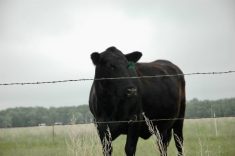Editor’s Note: Following are excerpts from a Jan. 15 blog post by the Economics branch of Farm Credit Canada. “As we start the new year amid new challenges, including slowing population growth and potential trade barriers, here are our top charts to help make sense of the economic environment for the agriculture and agri-food sector, from producers to consumers,” the farm lender writes.
Upcoming canola trade barriers
Uncertainty hangs over the 2025 canola market due to China’s anti-dumping investigation but also a smaller than anticipated Canadian canola crop. It will take time for China to conclude its investigation — China’s 2018 case against Australian barley took 18 months — but in the meantime, since the beginning of the crop year on Aug. 1, Canadian canola exports have been strong. Thanks to China accounting for over 75 per cent of all shipments, the export pace is running 10 weeks ahead of schedule. Even if China slows down as expected, Canada will only need to export another three million tonnes of canola to reach Agriculture and Agri-Food Canada’s export target of 7.5 million tonnes in 2024-25. China’s anti-dumping probe is more likely to impact 2025-26 exports.
Read Also

Claas brings 1000 Series SP forage harvesters to Canada
In mid-August, Claas unveiled its new line of Jaguar forage harvesters at an event in Visalia, California, deep in the heart of that state’s dairy region.

Canada’s 2024 canola crop of just under 18 million tonnes has been in demand by domestic processors in addition to the strong export pace. The canola crush sector is on track to process over 11.5 million tonnes this crop year. If exports slow more than anticipated, crushers could process closer to 12 million tonnes, but it would depend on farmer deliveries. The other factor to consider is demand for canola oil, which is currently price-competitive compared to other vegetable oils including soybean oil. Canola oil has found a home in U.S. biofuel programs to date but uncertainty surrounding the specifics of U.S. biofuel and government policies for 2025 leaves this market in limbo right now.
Overall, the impact on the remainder of 2024-25 canola marketings will depend on how U.S. biofuel policies change and any U.S. import tariffs, but these are balanced by smaller crop size. Current stocks-to-use estimates are anticipated to be tight but are priced appropriately relative to the long-term trend. The upcoming 2025-26 crop will likely be influenced more by China’s anti-dumping probe and 2025 weather. Reduced exports to China in 2025-26 could result in increased ending stocks if alternative export destinations don’t materialize. Prices would decline based upon the corresponding stocks-to-use trend.
High cow, heifer slaughter rates not conducive to herd rebuilding
The Canadian beef herd hit its lowest point in 30 years last year and when data is released for Jan. 1, 2025, it is expected to be smaller once more, despite another year of excellent to record cattle prices. In 2024, nearly half of the slaughtered cattle in Canada and the U.S. were heifers and cows, a three-year low but still historically high, which will result in the herd declining to start 2025. To see the herd start to grow in a year, the industry needs cows and heifers to make up less than 47 per cent of slaughter. Until that happens cattle prices will remain near record levels, which will undoubtably support retail beef prices. Don’t expect barbecue season to be a cheap one, given Canadians’ preference for beef means demand is expected to remain strong.

Cow-calf producers have benefited from high prices — some using the extra income to pay off debt from drought years, while others chose to leave the industry rather than expand their herds. Cow-calf profitability is expected to remain strong in 2025 and while herd rebuilding might start later this year, significant expansion won’t be seen for a few years. Rebuilding the herd will take several years of good weather and high prices. Fortunately, feed supplies improved last year.
While supply and demand fundamentals suggest a positive outlook for cattle prices, potential trade issues are a major concern. Tariff threats from the new U.S. administration could impact the Canadian-U.S. livestock sector due to the integrated North American market. The uncertainty around tariffs and vCOOL [U.S. voluntary country-of-origin labelling, due to take effect in 2026] may also hinder Canada’s ability to retain heifers for herd growth.
The cow-calf sector is not the only one reaping the benefits of high cattle prices. The Canadian dairy sector has also benefited. The milk per cow productivity gains has allowed the dairy sector to cull additional cows and send more calves to slaughter, increasing dairy revenue.
Rising costs will cap equipment sales
Over the last two years new equipment costs per acre have risen faster than farm revenue per acre, so much so that equipment costs as a share of farm revenues have soared to a decade high. So, it’s not surprising that sales of farm equipment have been weak.
New farm equipment unit sales are projected to remain soft through 2025 as farmers feel the pressure of lower commodity prices, high equipment prices, and tighter profitability. However, the decline in sales is expected to be less severe than in 2024, and sales of four-wheel-drive tractors should stay above the five-year average. This trend is not just in Canada; U.S. farmers are facing the same issue. Because of weak demand, U.S. farm equipment manufacturers have cut production.

This weak demand has also affected the used equipment market, leading to higher inventories. Last year, some dealers sold excess inventory at auctions for lower prices. We expect this trend to continue in 2025, with more used equipment being sold at auctions. However, new equipment prices might not come down all that much, because they are mostly set in U.S. dollars and with the forecast of a weak loonie through the year, this would pressure prices higher. Furthermore, if tariffs are added, prices of new equipment would increase further.
Overall, we expect overall equipment costs to better align with farm revenue than over the past two years.
Market analysis for Farm Credit Canada by senior economists Leigh Anderson, Graeme Crosbie, Amanda Norris and Justin Shepherd.




















